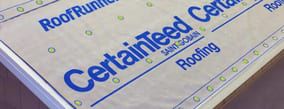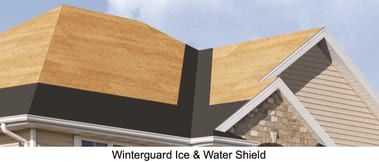New Roof Installation
Watch The Video Of How Louisiana Roof Crafters Installs Every New Roof
A new roof installation is not a difficult task for a team of experienced roofing professionals, but there are a few things you need to do and know to help the process go as quickly and smoothly as possible. Here are a few new roof installation tips for communicating with your roof contractor, as well as a pre-work checklist that can help you to minimize disruption prior to, during, and after the new roof installation.
Louisiana Roof Crafters has made this new roof installation video below to show everyone exactly how we install every roof. At Louisiana Roof Crafters, we feel it is important that you not only hear us tell you how we will install your new roof but watch how we install every new roof at Louisiana Roof Crafters. Watch the video below so you can have peace of mind on how your new roof with Louisiana Roof Crafters will be installed.
Proper Roof Install Techniques: Louisiana Roof Crafters' Approach
At Louisiana Roof Crafters, we understand the importance of proper installation techniques and materials. That’s why we want to share our step-by-step approach to new roof installation with you.
Step 1: Inspection and Material Check-In
Your new roof installation begins with the delivery of your roofing materials. Our team will inspect the materials to ensure they’re the correct ones and that nothing is missing. We take pride in our attention to detail to make sure that we have everything we need to install your new roof correctly.
ew runs into. In Baton Rouge, the Northshore, and all of Louisiana it is not an accepted practice to do what is called a roof over. This is where one layer of shingles is added on top of the existing layer.
Step 2: Tear-Off and Deck Inspection
Before we start installing your new roof, our team of roofing professionals will thoroughly inspect your roof deck to identify any areas of damage, rot, or decay. We believe in doing things the right way and will never cut corners by simply layering new shingles over old ones, a practice commonly known as “roof-overs.” Instead, we will completely tear-off your old roof to ensure a proper and secure foundation for your new one.
Once the old roof has been completely removed, we will carefully inspect the underlying deck for any signs of rot or decay. If any issues are identified, we will repair or replace the affected areas to ensure a strong and durable foundation for your new roof. Our team will also check for any irregularities in the roof deck, such as soft spots, dips, or bumps, that could affect the installation of your new roof.
Step 3: Install Drip Edge Around the Eave and Rakes of the House.
Drip edge, also known as eave flashing, is an essential component of your roof installation. It is installed at the edge of your roof’s eave and rake to protect against water damage and rot. Our team will carefully install drip edge to ensure it is securely in place and providing optimal protection for your home. This is an important step that is often overlooked by amateur roofers, but we take every detail into account to ensure your roof is built to last.


Listen to the Louisiana Roof Crafters podcast where Michael and Will tell you everything there is to know about roofing. Check out this episode on the new catch-all debris removal system that Louisiana Roof Crafters uses. You can browse the entire library of Louisiana Roof Crafters podcast episodes about any roofing topic that you may have a concern about. Check it out and leave your feedback. At Louisiana Roof Crafters, our client’s opinions matter.
Step 4: Synthetic Felt Installation
At Louisiana Roof Crafters, we use only the best materials for your new roof. This includes synthetic felt, a superior product to the old asphalt felt paper. Synthetic felt is stronger, water-resistant, and more puncture-resistant than traditional felt paper. We install the felt according to the manufacturer’s instructions, placing it over the drip edge at the eve of the home and under the drip edge running up the rakes.

Add Your Heading Text Here
Step 5: Starter Shingle Installation
During a new roof installation, it is essential to use a strong and properly installed starter shingle to protect the vulnerable areas of your home. The starter shingle has an adhesive to make the eve of your home more secure from wind and water damage. Some roofing companies try to cut corners by using a three-tab shingle backward as a starter shingle, which provides no adhesive protection for the eve of the home. This is a practice that only bad roofing companies will use.
At Louisiana Roof Crafters, we believe in using high-quality materials and proper installation techniques to provide superior protection for your home. We always use a new starter course shingle, such as the CertainTeed starter, to make a great protective barrier for your home. This is especially important in the areas of Hammond, Baton Rouge, and the Northshore, where high winds are common and hurricanes are always a possibility.
Step 6: Ice and Water Shield Installation
During the new roof installation, we make sure to include ice and water shield as an essential part of the process. This provides protection against leaks and water damage in the most vulnerable areas of your roof, such as valleys, chimneys, and roof penetrations like pipe jacks and whirlybirds.
Our team will apply the ice and water shield directly to the bare deck, cutting out the felt in the valleys to ensure proper installation. For optimal protection, we use CertainTeed’s Winterguard, a superior ice and water shield product specifically designed to safeguard your roof against water infiltration.
Step 7: Shingle Installation
When it comes to installing shingles, there’s a right way and a wrong way. At Louisiana Roof Crafters, we do it the right way. We always install our lifetime shingles in a course, never “racking” them as some other roofers may do. This ensures that your shingles will stay securely attached to the roof deck for many years to come.
In addition to proper installation techniques, we also use the highest quality shingles on the market. Our new roof installations include a limited lifetime shingle from CertainTeed, a company with over 100 years of experience in manufacturing high-quality shingles. These shingles are some of the heaviest per-pound on the market and come in a wide variety of colors to match any home’s style. With Louisiana Roof Crafters, you can trust that your new roof will not only be installed correctly, but will also look great and provide reliable protection for your home.
Step 8: Hip and Ridge Shingle Installation
Once the shingles are installed, the focus turns to the hip and ridge of the roof. Properly installed hip and ridge shingles not only add aesthetic appeal but also protect your roof from wind-driven rain and other weather elements. It’s important to use a true hip and ridge shingle for maximum protection, as a three-tab shingle is not designed to bend and cover the hip and ridge area effectively.

Add Your Heading Text Here
Step 9: Ridge Vent and Ventilation Installation
After the installation of the hip and ridge shingles, the next step is the installation of the ridge vent. Proper roof ventilation is crucial to the longevity and durability of your new roof. Without proper ventilation, your roof may become too hot and lead to premature shingle failure.
At Louisiana Roof Crafters, we use the 12” CertainTeed ridge vent on the peak of your home. This high-quality product works well year-round and is wind-driven rain resistant to 100 MPH. During the installation of the ridge vent, our roofing professionals make sure to cut out the ridge area and not cover it with felt. This ensures that the ventilation system can function properly and keep your roof at the optimal temperature.
Step 10: Finishing Touches
After the hip and ridge installation is complete, our team will make sure that any roofing hardware that did not come pre-painted is properly painted to match your new roof. This includes plumbing pipe boots, turtle vents, wind turbines, and flashings, among others. We understand the importance of attention to detail and strive to make your new roof installation as seamless and aesthetically pleasing as possible.
Step 11: Final Clean-Up
Once the installation and painting are complete, our team at Louisiana Roof Crafters knows that a thorough clean-up is just as important. Our roofing crew will ensure that your property is left spotless by sweeping the driveway, yard, and flowerbeds for any roofing debris and nails. We believe that our job isn’t complete until we’ve left your property looking just as good as when we arrived. You can trust us to take care of every last detail, leaving you with a beautiful, secure, and clean new roof.
These are some good guidelines for you to watch as your new roof is installed. Make sure to talk to your roofing consultant about every part of the process. A top roofing company will be proud of the way they install your roof. Only poor roofers hide their install process and do not want you to see it nor do they like questions about how they roof. Louisiana Roof Crafters welcomes questions and loves to show and talk about the proper way to install a new roof.
Expert New Roof Installation: Eliminate the Guesswork with Louisiana Roof Crafters
Some amateur roofers think that more sealant is better, but did you know that too much sealant can actually lead to leaks and damage? This is because excess sealant can create a buildup that blocks proper water drainage, causing water to pool and eventually seep through the roof.
At Louisiana Roof Crafters, we take the guesswork out of roof installation by using our expertise and experience to ensure that every aspect of the process is done right. Our team of highly skilled roofing professionals understands the proper amount and placement of sealant needed for a secure and long-lasting roof.
When it comes to new roof installation, our team uses only high-quality materials and the latest installation techniques to ensure that your roof looks great and performs well for years to come. As a CertainTeed Select Shingle Master Mandeville Louisiana roofing contractor, we are among the top 1% of roofing companies in the country providing the best residential roof replacement.
We also offer a range of roofing options to fit your needs and budget, from traditional asphalt shingles to energy-efficient options. Plus, with our Equipter New-Roof No-Mess debris removal system, you won’t have to worry about a messy cleanup or damage to your lawn and landscaping.
Refrain from trusting your new roof installation to just anyone. Contact Louisiana Roof Crafters today to schedule your consultation and experience the difference of working with a top-rated roofing contractor.

Experience the Best in Roofing: Schedule Your Free Consultation with Louisiana Roof Crafters Today!
Are you in need of a new roof installation but not sure where to turn? Look no further than Louisiana Roof Crafters. Our team of experienced professionals is dedicated to providing exceptional customer service and top-quality craftsmanship on every project. From start to finish, we’ll work with you to ensure that your new roof meets all of your needs and exceeds your expectations. Contact us today for a free consultation and see why we are the trusted and reliable choice for your new roof installation.
Unveiling the Proper Way to Install Your New Roof: Don't Fall for Poor Roofing Practices!
When it comes to your new roof installation, it’s important to be informed and involved every step of the way.
At Louisiana Roof Crafters, we take pride in our installation process and welcome any questions you may have. Our roofing consultants are knowledgeable and transparent about the proper techniques and materials used for your new roof. We believe that the more you know about the installation process, the more confident you can be in the quality of our work.
Don’t settle for poor roofers who hide their installation process and don’t want to answer your questions. Choose Louisiana Roof Crafters and let us show you the proper way to install a new roof.

Don't Get Caught Off Guard: Essential Questions to Ask Your Roofing Contractor
To ensure a successful and stress-free new roof installation, effective communication with your roofing contractor is key. Asking the right questions can give you a better understanding of the process and help you make informed decisions. Here are some essential questions to ask your roofing contractor before the installation begins:
1. When Will the Shingles Arrive?
Shingles are usually delivered a few days before or on the day of the installation project. It’s important to talk to your roofing representative about your specific situation, such as any neighborhood bylaws or space limitations for the amount of roofing materials required.
The delivery driver will typically drop off the shingles in your driveway, but you can also request a different location if needed. To avoid any inconvenience or disruption, ask your roofing contractor when the shingles will arrive. While the exact delivery time may not be known, having a general idea can help you prepare and move any vehicles or obstacles out of the way.
2. Will My Flowers and Shrubbery be Protected During Installation?
During a roof installation, debris from the work can cause damage to flowers and shrubbery. Some roofing contractors offer to cover plants to prevent damage, while others leave the responsibility to homeowners. It’s important to ask your roofing contractor about their plan for protecting your yard during the installation process.
At Louisiana Roof Crafters, we take extra precautions to protect your property during installation, including covering and securing any vulnerable plants. We also use the Equipter mobile roofing debris trailer, which is designed to prevent debris from falling onto your yard and can easily lift over delicate shrubs.
If you have any specific concerns about the protection of your flowers or shrubbery, make sure to communicate them with your roofing representative. They may be able to offer additional measures to ensure your yard remains unscathed during the installation process.
3. What is the Clean-Up Process?
A new roof installation can create a mess with leftover shingles, nails, and other debris. It’s important to discuss the clean-up process with your roofing contractor before the job starts. At Louisiana Roof Crafters, we take care of cleaning up all debris associated with the new roof installation.
However, if you’re not satisfied with the clean-up, don’t hesitate to ask the contractor to do a secondary sweep for nails. During any re-roofing project, there will be thousands of nails and hundreds of square feet of roofing felt torn off your roof. While we take every care possible to clean up all debris, sometimes a few nails can get caught in the grass.
To help with the clean-up process, consider mowing your lawn before the installation. This will make it easier for the magnets used to drag your yard to pick up any remaining nails. By discussing the clean-up process beforehand and taking some extra precautions, you can ensure that your yard is free of debris and your new roof looks great.
4. What is the Warranty On My New Roof?
To ensure that you have peace of mind and protection for your investment, it’s important to ask your roofing contractor about the warranty that comes with your new roof. Make sure you understand the terms and coverage of the warranty, and ask whether you or the contractor is responsible for registering it.
At Louisiana Roof Crafters, we use CertainTeed roofing materials which come with a strong warranty. We take care of registering the warranty on your behalf and it will be uploaded to your SSA client portal once the roofing project is complete. SSA is our cloud-based CRM program that stores all your roofing information, including warranty details, so you can access it from any device at any time. With our comprehensive warranty and SSA program, you can have confidence in your new roof for years to come.
New Roof Installation Pre-Work Checklist: Be Prepared for a Smooth Project
Installing a new roof can be a big undertaking, and it’s important to be prepared for the process. To help minimize disruption and ensure a smooth installation, here are some key items to consider before the work begins.
1. Protect Your Pets
During a new roof installation, it’s important to consider the safety and well-being of your furry friends. Be sure to ask your roof contractor whether your pets need to be put up or kept away during the installation process. Dogs and cats can be injured by falling debris, and they may also get in the way of contractors, which can be dangerous for both the workers and the animals.
Additionally, the loud noise produced during the roofing process can be stressful for pets, especially if they are sensitive to loud sounds. If you have a particularly sensitive pet, you may want to consider boarding them for the duration of the installation to ensure their safety and comfort. Taking these precautions can help protect your pets and provide peace of mind during the new roof installation process.
2. Protect Your Property
During the installation process, there may be a lot of noise and vibration, which can cause items inside your home to shift or fall. To protect your valuables, consider covering them with drop cloths or moving them to a safe area.
Roofing crews walking on the roof, nailing of the shingles, and laying the bundles of roofing shingles on the roof’s deck and ridge can in some cases cause severe vibrations. One bundle of CertainTeed, which is the heaviest shingle on the market, can weigh 240 LBS or even more if you are installing a class four shingle.
3. Inform Your Neighbors
New roof installation can be a noisy and disruptive process, which may affect your neighbors as well. To avoid any complaints or issues, consider informing your neighbors ahead of time about the project and the expected timeline.
4. Discuss Communication and Expectations with Your Contractor
Before the installation process begins, discuss communication and expectations with your roofing contractor. Ask about their communication process, and how you can expect to be updated on the project’s progress. Additionally, make sure you are clear on what to expect during the installation process, including potential noise and disruptions.
5. Clear Your Driveway and Yard
Roofing contractors will need access to your driveway and yard during the installation process. Before work begins, remove any cars or other items from your driveway to allow space for the roofing truck and equipment. Also, consider clearing any items or furniture from your yard to prevent potential damage from falling debris.
6. Rare and Unexpected Things but Possible
While it is rare, unexpected things can happen during a new roof installation. For example, a nail may penetrate the roof’s deck and hit water, A/C, or electric lines. This is why it is important to ensure that all lines are installed to code and strapped down to the rafters or other flooring joists.
Unfortunately, there is no way to know prior to the new roof installation if this could happen, and even if the attic was inspected, there may still not be any way to see it. In some cases, the lines that are hit may be at the very edge of the house and may not be visible. It is important to be prepared in case this happens, and to work with your roofing contractor to resolve any issues that may arise.
Post-Installation Checklist: What to Do After Your New Roof is Installed
On the final day of the new roof installation, it is helpful for you to know what to expect. Here are a few things you need to do to help your roof contractor finish the job.
1. Be Present for the Final Walk-Through
After the new roof installation is complete, it’s essential to conduct a final walk-through with your roofing contractor. This will allow you to inspect the installation and ensure that the clean-up is satisfactory. Additionally, you’ll have the chance to ask any final questions you may have about your new roof.
At Louisiana Roof Crafters, we always conduct a final walk-through with our clients to ensure their complete satisfaction. During this walk-through, our representative will explain important details about your new roof, such as the importance of the thermal seal and the reason for slightly raised shingles in valleys and around chimneys. By having a thorough understanding of your new roof, you can rest assured that it will function optimally for years to come.
2. Settle Your Account
Once the new roof installation is complete and you are satisfied with the work, it’s time to settle your account. The company representative will provide you with the roofing completion certificate and collect the first check or ACV amount (actual cash value). Keep in mind that the RD (recoverable depreciation) check will come later after the roofing company sends in the final invoice to your insurance company. This check should arrive within ten days to three weeks, depending on how busy they are and how many wind and hail storms there have been in your region. If you have any concerns or issues with the new roof installation, be sure to speak to a company representative so they can be addressed promptly.
3. Don’t Move Leftover Material
It is important to leave the leftover roofing material in place after the new roof installation is complete. Louisiana Roof Crafters orders extra materials to ensure they have enough to finish the job and match the color of your new roof. The roofing company will come to pick up the leftover materials within three business days after completing the installation. Moving the materials yourself can cause damage to your property or create a safety hazard.
4. Receive Your Warranty
Once the final payment for your new roof installation has been received, your roofing warranty from CertainTeed and Louisiana Roof Crafters’ workmanship warranty will be added to your SSA client portal. This portal will be accessible to you indefinitely, so you can review your warranties and other roofing information at any time. If you have any questions or concerns, you can always contact Louisiana Roof Crafters or access your SSA client portal by visiting the Louisiana Roof Crafters website.
Add Your Heading Text Here
Stay Connected and Informed with SSA Client Portal During Your Roof Installation
As a homeowner, it is crucial to stay up-to-date and informed during the entire new roof installation process. With Louisiana Roof Crafters, you have access to the SSA Client Portal which provides detailed information and keeps you connected with your roofing project.
From pre-job pictures and insurance scope of loss to warranty information, the SSA Client Portal has everything you need to stay informed about your roofing project. Simply log in and click on ROOF to access all relevant roofing files and updates.
By utilizing the SSA Client Portal, you can ensure that you are always aware of what is happening during the installation process and have access to all necessary information. If you still have questions, our customer service representatives at Louisiana Roof Crafters are always available to address any concerns you may have.
Frequently Asked Questions About A New Roof Installation
Are the type of roofing shingles used important?
Re-roofing your home is a big decision. Roofing shingles manufactured today are designed to last for decades if you buy good shingles and they are installed correctly. When making a decision on what type of roofing shingles to buy, certainly take cost into account for sure but make sure you look at all aspects of your situation and get expert roofing advice so when you do secede you make the right decision.
Why should you tear off the old felt from the roof deck?
If your roofing contractor tells you it is not necessary to tear the old roofing felt off your roof during a re-roofing project, he is trying to save money and cut corners. Yes, it is necessary to tear the old roofing felt off the deck if you want the best roofing job done. One good reason to tear the old felt off your roof’s deck is to inspect your roof’s deck for rotten wood. If you do not tear the old felt off, you will most likely miss areas of rotten wood and roof right over it. Top roofing companies will always tear the old roofing felt off and only install the new synthetic felt.
Is drip edge important to my overall roofing job?
Drip edge is another place that many roofing companies cut corners on. Many roofing companies will not remove the old drip edge and install new ones. Some will even use an excuse like you don’t want any more nails at the end of your roof deck. Many roofing companies will use any tactic to spend less on your roof and pocket more themselves. Drip edge is what keeps the rainwater from getting on your fascia and keeping it from rotting over time.
Is it necessary to use synthetic felt?
No, it is not necessary to use synthetic felt when doing a re-roof project. At Louisiana Roof Crafters and other top roofing companies installing synthetic felt is the only acceptable type of roofing felt. Some of the reasons Louisiana Roof Crafters only uses synthetic start with water penetration. The old asphalt felt of yesterday just will not stop water penetration and your roofing felt is the last line of defense for your roof’s deck. The warranty is also much better on synthetic felt as well. So, even though it is not 100% necessary to use synthetic felt during a roofing project, your elite roofing companies will not install asphalt felt.
What about ice & water shield in my valleys?
The old way of doing the valleys during a re-roof project is valley metal. Today there is a much better product for a home’s valleys called ice & water shield. A product like WinterGuard by CertainTeed corporation will eliminate the possibility of rust around nail penetrations as wells as expansion and contraction which all metal will do. Again, elite roofing companies will not install valley metal and opt for a much better ice & water shield.
Add Your Heading Text Here

What type of ventilation should I have?
Proper roof ventilation is a question to ask a roofing professional when at your home. The best product for long-term attic ventilation is a ridge vent. Ridge vent will give you consistent ventilation over time and many improvements have been made over the years making wind-driven rain issues a thing of the past. The only problem is with today’s modern homes you can’t always get enough ridge vent on the home to properly vent the attic leaving you with options like wind turbines and power attic vents. Ask your roofing professional what they would use if they were roofing their home.
Add Your Heading Text Here
What type of ridge shingles are best for my roofing job?
The hip & ridge shingles are one of the most important components of your roof and so often not even explained properly by a local roofer. Most roofers will not even talk about the ridge shingles and just put what is called a 3-tab shingle on your hip & ridge. The 3-tab shingle is made for the main parts of your roof called the field shingles. The 3-tab shingle is made to lay flat and not bend at all.
As soon as you bend a 3-tab shingle as you must do to install it on a hip & ridge you damage the shingle and it is just a matter of time before it will allow water into your home. This is again where a top roofing company will at least explain the difference in the types of ridge shingles and let the homeowner make the decision and many times it comes down to saving money. The hip & ridge shingle is not that much more expensive and will give your roof much better protection.
What warranties are available?
There are so many different types of shingle warranties for different types of singles the only way to properly cover this topic is with your roofing field representative. As your roofing representative is going over shingles with you tell him or her what your expectations are and that will help narrow down what shingles they even show you. At Louisiana Roof Crafters, we only install CertainTeed and Owens Corning shingles. CertainTeed and Owens Corning have the best shingles and shingle warranties on the market today.
How will you clean up all that roofing debris?
At Louisiana Roof Crafters, we use the Equipter new roof no-mess system to help keep your lawn cleaner during the roofing project. It is not always practical to use the Equipter around the entire house, sometimes there just is not enough roof to get the Equipter by the side of the house between fencings and A/C units. This is when Louisiana Roof Crafters will tarp thoroughly around your home to catch all the loose roofing nails and debris. At the end of the job, the roofing crews will pick up all remaining debris, rake, and use magnets to get the last remaining nails.
Can anything go wrong during my roofing project?
Yes, there are many things that can go wrong, and you should read every word of the pre-job checklist for all these. Most things that can go wrong are rare but can and do happen from time to time. Have your roofing field representative show you where to read your roofing pre-job checklist.




